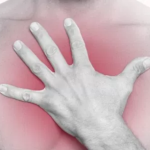How do abdominal hernias appear?
A hernia of the abdomen is the exit of internal organs under the skin or into an adjacent cavity through weakened sections of the muscles of the abdominal wall. The disease is common among young children and adults with congenital anomalies of the musculoskeletal system. Signs of abdominal hernia are determined visually, and confirmation of the diagnosis is carried out by ultrasound. Pathological protrusion can be of different localization, on which the clinical manifestations and the choice of treatment tactics depend, but any formation requires surgery, the only question is the urgency of its implementation.
In children, congenital inguinal and umbilical hernias are more often diagnosed; in adults, in addition to these forms of the disease, there is a higher risk of protrusion in the region of the Spigelian and white line of the abdomen. A rare localization will be a hiatal hernia, which in most cases is asymptomatic and is detected incidentally.
Why does a hernia occur
There are congenital and acquired factors of the disease. In the first case, we are talking about intrauterine developmental anomalies that contribute to the exit of the abdominal organs through weakened anatomical openings.
Congenital factors do not always lead to the birth of a child with a hernia, but they will form the conditions for the occurrence of pathology throughout life.
Acquired factors relate to lifestyle, systemic diseases, surgeries and injuries. Active people have a lower risk of the disease, but heavy physical activity will contribute to the onset of the disease. In women, a common cause of abdominal hernia is pregnancy, during which intra-abdominal pressure rises and the muscles of the anterior abdominal wall diverge. In men, the appearance of a hernia is more often associated with heavy lifting, traumatic work, excess weight and frequent damage to the abdominal muscles.
Common provoking factors for the occurrence of a hernia of the abdominal cavity:
- age-related changes, leading to a decrease in elasticity, muscle wear;
- genetic predisposition;
- muscle strain during pregnancy, difficult childbirth;
- sudden weight loss, cachexia;
- obesity, sedentary lifestyle.
Predisposing factors will also be frequent hysterical cough, constipation, playing wind instruments. Anything that increases pressure inside the abdominal cavity can cause a hernia. Each factor alone is not dangerous, but when several of them are combined, the likelihood of the disease is very high.
How does a hernia of the abdominal cavity manifest itself?
How to identify a hernia of the abdomen in adults and young children:
- rounded or oval protrusion in the abdomen;
- aching pain in the side and lower abdomen, radiating to the lower back;
- with a large hernia, there is a sharp pain during movement;
- difficulty urinating, constipation, bloating, rumbling in the abdomen.
Hiatus hernia has several other manifestations:
- no external signs;
- chest discomfort;
- nausea after eating;
- frequent hiccups and belching of sour contents;
- heartburn that occurs after eating;
- pain on bending over.
Patients with femoral hernia have concomitant disorders of urination and defecation. Periodic pain in the lower abdomen may disturb, especially while walking.
Types of disease
Abdominal hernias are distinguished by anatomical and clinical signs. Allocate congenital and acquired formations. The first occur in newborns, and more often they are located in the groin and umbilical ring. Dangerous for the child will be a congenital diaphragmatic hernia, which requires immediate surgery.
Umbilical and inguinal hernias in a child can disappear on their own, but this happens extremely rarely, and the risk of complications is much higher than the likelihood of recovery without surgery.
Congenital hernias of the abdominal cavity can be recognized by a characteristic protrusion in the groin, in the side, or along the midline of the abdomen. When a child is born with a hernia, the surgeon prescribes a planned operation, and the sooner it is performed, the lower the risk of unpleasant consequences for the baby in the future.
Acquired forms of hernias occur in both children and adults, they can be:
- postoperative;
- traumatic;
- artificial;
- from muscle weakness;
- from high load;
- from a sharp increase in intra-abdominal pressure.
Congenital and acquired hernias are more often external, that is, the organs go through the muscle layer under the skin.
Internal forms of the disease are characterized by protrusion of various structures (stomach, intestinal loops, bladder) into the adjacent cavity, folds and pockets of the peritoneum. This is a rare type of disease; such hernias are diagnosed in 15-20% of patients. These are poorly recognizable hernias that are visible during ultrasound or MRI, and they only disturb certain rare symptoms: malaise, discomfort, rumbling in the abdomen.
Uncomplicated
A hernia of the abdominal cavity without complications is characterized only by a change in the anatomical position of the organs without any other disturbances. The first signs of the disease are difficult to notice if the formation is small in size and does not give painful sensations. The patient's condition does not change, the quality of life does not suffer. The absence of severe symptoms complicates the diagnosis, and therefore the doctor is often treated with complications, when it is impossible to walk, eat, sleep and do other things normally due to constant pain and a large hernia.
Complicated
A hernia with associated complications is dangerous in such conditions:
- coprostasis, intestinal obstruction - feces linger in the clamped part of the intestine, intoxication and poisoning of the body occurs, without timely help, the organ wall ruptures, the contents enter the abdominal cavity, peritonitis begins;
- infringement - during a sharp increase in pressure inside the abdominal cavity, organs are compressed, tissues are compressed, an inflammatory process begins, outwardly this is seen as an increase in formation, which ceases to be put back into place, the patient is disturbed by severe pain, malaise, nausea and vomiting;
- peritonitis - inflammation of the peritoneum may be due to rupture of the intestine or perforation of the stomach, this is a serious condition that requires immediate surgery.
recurrent
A frequently recurring hernia of the abdominal wall is a type of disease in which a bulge appears several months or years after surgery. The protrusion occurs in the same place, which is associated with muscle weakness. The reason for this phenomenon is factors that do not depend on the approach to treatment, but the mistakes of the surgeon and the patient himself also affect the risk of relapse after the next operation.
Repeated hernia of the abdomen often occurs after tension plasty, when the defect is sutured with the patient's own tissues. The risk of recurrence is lower when performing hernioplasty with a mesh implant.
inguinal
A hernia in the groin is more often diagnosed in men and newborn boys, in women this location of the defect is rare, but an increase in intra-abdominal pressure during pregnancy can provoke a pathology.
With an inguinal hernia, the abdominal organs protrude into the inguinal canal or scrotum. An external sign will be swelling in the groin area, in women the labia changes, in men with an inguinal-scrotal hernia, the testicle increases.
Symptoms of an inguinal hernia:
- discomfort and mild soreness in the groin area, aggravated by walking, lifting weights and muscle tension;
- increased education during coughing;
- violation of urination;
- frequent constipation, pulling pains in the lower abdomen.
white line hernia
A preperitoneal lipoma or hernia of the white line of the abdomen is a protrusion of organs through a gap in the midline of the abdominal wall. This arrangement of education gives more vivid symptoms. The patient is concerned about nausea, gas and fecal retention. When a hernia of the white line is infringed, a strong pain syndrome appears, spasms torment, and the clinical picture in many ways resembles an exacerbation of peptic ulcer.
femoral
A protrusion in the thigh area appears more often in women, the hernial sac can contain the omentum and part of the intestine. The patient complains of pain while walking, but other symptoms may be absent for a long time.
umbilical
An umbilical hernia is an exit of the abdominal organs through a weakened umbilical ring. Pathology is often diagnosed in newborns and children under 5 years of age due to poor fusion of the umbilical cord. The risk group includes children who start walking early, due to the high load on the muscles of the anterior abdominal wall.
This form of the disease can be treated with conservative methods, but surgeons recommend in any case to perform an operation in order to prevent re-protrusion of the organs.
Lateral
Rare types of hernia will be formations in the region of the Spigelian line and the sheath of the rectus muscle. Outwardly, a protrusion ranging in size from 1 to 10 cm is visible, giant lateral hernias from 30 cm are less common. Diagnosis of a hernia of the abdomen with this arrangement is difficult, the protrusion may be insignificant and not disturb the patient.
Diagnostic methods
Diagnosis of a hernia of the abdomen is carried out by ultrasound. The surgeon already at the external examination makes a preliminary diagnosis and can prescribe conservative treatment to prevent infringement and other complications. Additional research methods are needed for a detailed description of the patient's condition, detection of hidden disorders, assessment of the state of the organs in the hernial sac.
Investigations for hernia of the abdominal cavity:
- Ultrasound - allows for differential diagnosis with other pathologies of the gastrointestinal tract and small pelvis, the doctor has the opportunity to examine the contents of the hernial sac and surrounding structures in order to select the optimal treatment;
- irrigoscopy - a study of the colon with the introduction of a contrast agent, the method is used to diagnose asymptomatic and internal hernias of the abdominal cavity;
- CT and MRI - computed and magnetic resonance imaging allow you to examine the pathological focus with maximum accuracy, identify the slightest violations and prerequisites for them, MRI is safe for the smallest and can be performed several times.
Symptoms of complications
With an uncomplicated hernia of the abdomen, the doctor may prescribe conservative treatment for the period of preparation for surgery. At any moment, infringement can occur, which is difficult to predict, even observing preventive measures. It is important to know how complications manifest themselves in order to immediately call a doctor, otherwise, without timely help, necrosis of internal organs occurs with a risk of death.
Common signs of a complicated hernia that require immediate attention include:
- acute pain in the abdomen;
- vomiting with blood;
- spontaneous urination;
- pallor or blueness of the skin;
- lack of protrusion push when coughing;
- an increase in the volume of the abdomen, its hardness.










